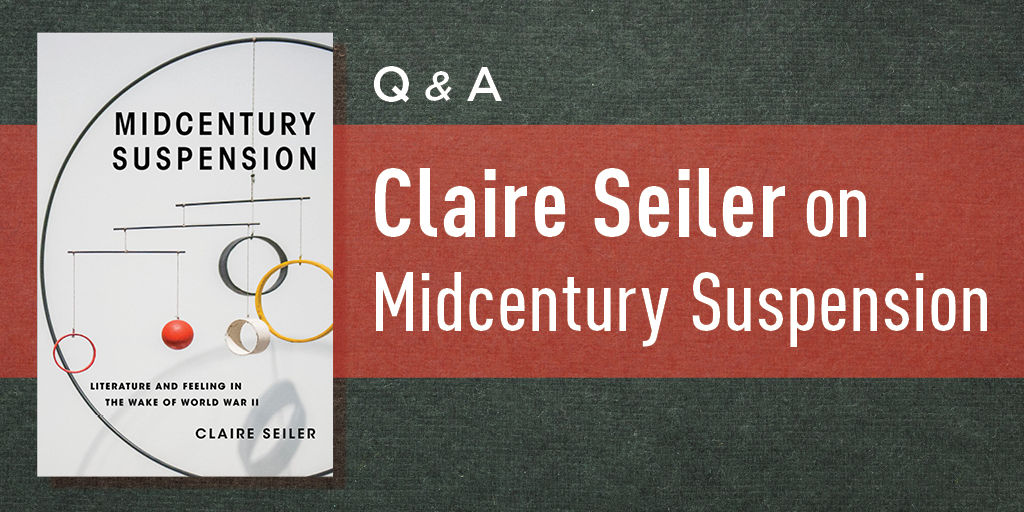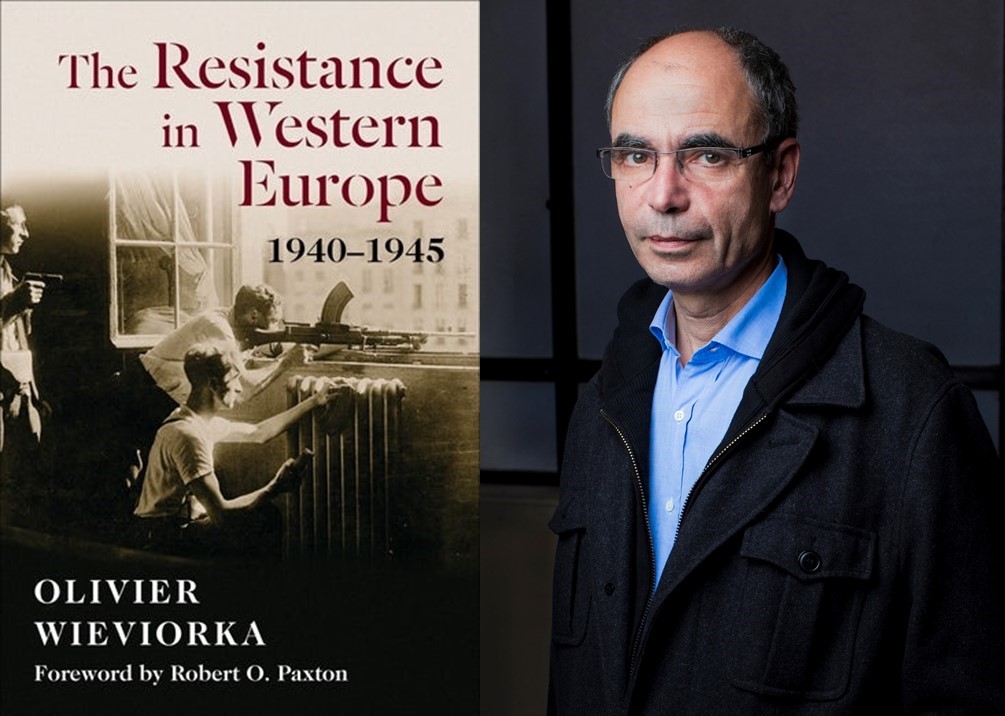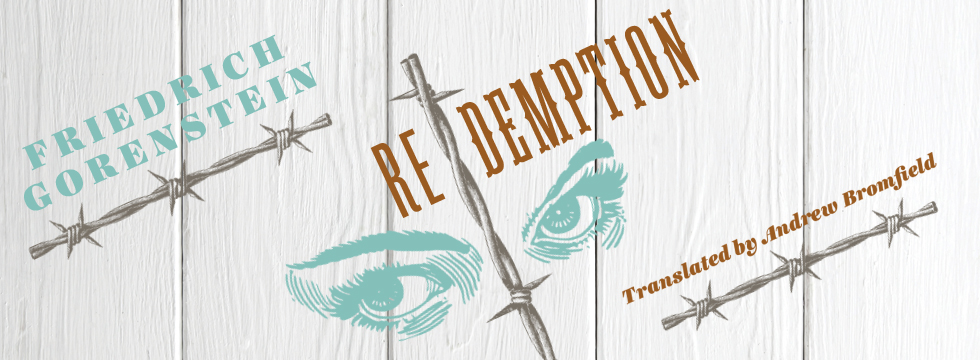Q&A: Claire Seiler on Midcentury Suspension

“It is impossible not to be impressed by the highly accomplished results on offer in Claire Seiler’s reconfiguration of early postwar transatlantic literature in terms of the concept of the “midcentury” and the forms of temporal and theoretical suspension she identifies with it. I suspect that her revisionist efforts to construct the intellectual framework of the midcentury and its suspensions will significantly reshape our understanding of this period for years to come.”
~Deak Nabers, author of Victory of Law: The Fourteenth Amendment, the Civil War, and American Literature
Today marks the seventy-fifth anniversary of the end of World War II. To commemorate this historic moment, we are featuring a Q&A with Claire Seiler, the author of the new book, Midcentury Suspension: Literature and Feeling in the Wake of World War II.
Check back throughout the day and follow us on Facebook, Twitter, and Instagram for book excerpts and posts related to WWII.
• • • • • •
Q: Beginning with its title, your new book foregrounds midcentury and suspension as concepts worth investigating. How so?
Claire Seiler: My book shows how feelings of historical suspension—of in-betweenness—shaped a remarkable range of literary works and cultural expression in the immediate aftermath of the Second World War. I analyze how this body of literature and public discourse spoke from, and to, its own self-conscious situation of inhabiting the middle of the twentieth century.
Everybody knew that the midcentury mark was an arbitrary distinction. Yet the print culture of the Anglophone North Atlantic went wild for it. Nonfiction books, reviews, magazine stories, newspaper columns, poems, and novels constantly gestured to the experiential, atmospheric, and felt historical conditions of the midcentury itself. Writers turned the now-humdrum word midcentury into something like what Raymond Williams, also in the early 1950s, was beginning to conceptualize as a “structure of feeling.” According to these accounts, the midcentury felt irreducibly middle, betwixt and between, incipient and belated. The word for all of this is suspension. But while suspension has fascinated aesthetic and cultural theorists pretty much from Aristotle on, I didn’t so much apply this rich concept as find it in the literary and print cultures of the midcentury.
Q: Between what states, moments, or eras, did midcentury writers feel themselves suspended?
CS: Certainly, the Second World War and the atomic age. Between (or amid) the accelerated dismantling of colonialism and the tense stand-off of the nominally “cold” war. Between the great promise of the twentieth century, as the epoch had been hailed in 1900, and the sense of peril by 1950, or of doubt as to how or whether the century would see its end. The list goes on and on—and in fact midcentury writings frequently replayed such lists of historical conditions. Along with itemizing events and phenomena, these lists summoned up both the intense historical pressure the midcentury was understood to bear and stressed how that pressure felt: like suspension.
Q: Why hasn’t the idea of midcentury suspension been part of the critical conversation in literary studies and cultural history?
CS: Many reasons. The simplest is a persistent belief that transatlantic midcentury literature was plain wanting compared to what had preceded it, and that it knew itself to be so. Another is that midcentury discourse played rhetorical host to a range of ideas that, my book shows, came to outlast their specifically midcentury occasion in literary and intellectual histories of the long postwar. It’s also tough to see around the larger, more institutionalized period categories that organize twentieth-century literary studies and related disciplines. Literary criticism likes boldface periods and clear timelines; it likes its beginnings and endings in sequence, not all at once. The midcentury doesn’t easily oblige.
Consider that in the Anglophone North Atlantic context, two established—and mutually reinforcing—period timelines chart the long arc of modernism and a train of ostensibly discrete wars and wartimes across the twentieth century. You can read midcentury literature for modernism or for war, as these are already understood, and you can value works according to standards set by modernism or militarism. But this practice all but precludes you from crediting how writings of the late 1940s and early 1950s articulated an experience of the present as possibly alternative to these logics. According to a great deal of its literature, the midcentury was neither inevitably disposed to continuous violence nor destined to follow feebly behind the famed modernist “heave.”
Q: The cold war, or early postwar, was a famously anxious time, as the image of the Doomsday Clock is often used to illustrate. Readers of Midcentury Suspension might be surprised to find that the book troubles the familiar association of the postwar with anxiety.
CS: Yes. Well, to be clear, you’d be hard-pressed to argue that the early cold war wasn’t an anxious time. But several factors—among them, the accumulated intellectual prestige of anxiety and the popularization of anxiety as a psychological diagnosis—combined to make postwar anxiety seem inevitable and apolitical. It was neither.
In a chapter titled “W.H. Auden, Ralph Ellison, and the Midcentury Anxiety Consensus,” I reconstruct the broad-ranging discursive promotion of anxiety as the feeling required of democratic citizens after the Second World War. I dig into how and why Auden’s and Ellison’s signal works of the midcentury critiqued its emerging emotional consensus. The elevation of the title of Auden’s postwar-era-naming long poem The Age of Anxiety (1947), for example, required willful misreading of its treatment of the war, which drew affectively from Auden’s service in the U.S. Strategic Bombing Survey. Ellison’s classic novel Invisible Man (1952) perceives and resists the implicit whiteness of the model anxious citizen; further, by dramatizing the inherited and lived anxiety of its unnamed protagonist as he confronts various white supremacist institutions in the U.S., the novel casts doubt on the promise of anxiety as a grounds for full, equal, and participatory democratic citizenship.
Q: Midcentury Suspension draws on original archival research on writers including Elizabeth Bishop, Frank O’Hara, and Elizabeth Bowen. As you’ve indicated, the book also situates its literary readings in the rangier record of transatlantic print and periodical culture of the midcentury. Can you share with us a couple of your favorite finds from this wider research?
CS: Among dozens, two examples spring to mind immediately:
-
-
- Newspaper reporting on President Harry S. Truman’s rededication, in 1950, of Memorial Day as “a day of prayer for permanent peace” and of newspaper poems and prayers that obliged. The presidential call and public response sharpen the midcentury occasion and antiwar poetics of World War II veteran Frank O’Hara’s vital early poem “Memorial Day 1950.”
- Pittsburgh Courier columnist Marjorie McKenzie’s beautiful description of her “own intensity about 1950” as a “widely shared emotion” and an embodied experience of suspension. Published on January 14, 1950, McKenzie’s column both crystallizes the feeling of midcentury suspension and participates in African American journalists’ coverage of the midcentury fanfare. Much of this coverage channeled the demonstrable public resonance of the year 1950 toward shaming the U.S. for entrenched racial segregation and pushing the country to realize its promise for, and repay its obligation to, Black citizens before century’s end.
We encourage our readers to support independent bookstores, especially those owned by people of color. Bookshop.org makes it easy to order from bookstores across the nation. Visit LitHub for a curated list of black-owned bookstores.
-








